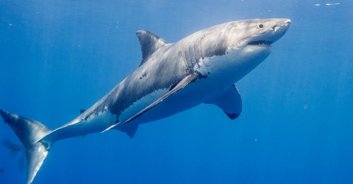A photographer has taken a snap of what is believed to be the only albino humpback whale in the world.
The 40ft-long humpback whale, known as Migaloo, was spotted swimming alongside another whale in the waters of New South Wales.
The ensuing photograph was taken by Craig Parry, who was four miles off Cape Byron when he made the incredible discovery.
"There has been numerous sightings of the white whale ”Migaloo” heading north between south coast NSW and Byron Bay. Let's hope we get catch up with our old friend at some stage! Swipe right to see a detailed tail crop, scientists use this to identify Humpbacks," the 41-year-old wrote on Instagram.
The photographer added: "Honestly there aren’t many milestones as an artist, but I would have to say I count this moment with Migaloo as a significant time in my life, not just as a photographer but human. This year is looking incredibly inspiring for me as I hit the Barrier Reef / Tonga / Africa and Europe, it’s a year I want to help connect humanity back to nature [sic]."
"Considered to be the most famous humpback whale in the world, Migaloo may be the only pure white adult humpback whale alive today," the Pacific Whale Foundation writes on their website, regarding Migaloo.
"This remarkable whale was first spotted in 1991 off Byron Bay, Queensland by a group of volunteers conducting a whale count. The first photograph of Migaloo was taken through a telescope from a distance of over 5 km away. It was blurry and unclear if he was all white. In 1993 Pacific Whale Foundation researchers encountered this amazing white whale in Hervey Bay, Queensland. During this encounter we were able confirm the whale was all white and in 1998, we recorded the whale singing, a trait distinct to male humpback whales. Genetic testing in 2004 by Southern Cross University scientists further confirmed that Migaloo is a male; this confirmed what we knew because Migaloo has been recorded singing and only male humpback whales produce song.
There are a number of ways in which scientists identify Migaloo. The obvious characteristic is that he is all white, but we use other physical traits as well: his dorsal fin (on his back) is slightly hooked and his tail flukes have a distinctive shape, with spiked edges along the lower trailing side."



